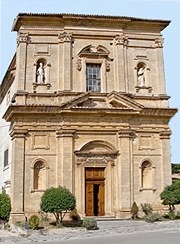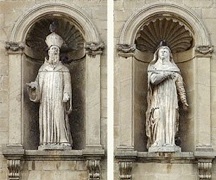


This church stands in what were once meadows (as the name suggests).
A small church here belonged to the nuns of the nearby Monastero di Santa Maria del Paradiso, where the Blessed Gennara (died 1293) had spent much of her life. According to tradition, the church stood on the site of the house that the Blessed Gennara had shared with her husband, the Blessed Sperandio (died 1260). (Later tradition also claimed the church as the home of “Sperandia, hora protettrice di Cingoli”, probably because the Blessed Sperandia (died 1276) was erroneously believed to have been the sister of the Blessed Sperandio.)
The nuns of Santa Maria del Paradiso moved to a new nunnery, Santo Spirito, inside the city walls in 1468, and ownership of the small church moved with them. In 1662, an image of the Madonna and Child in this church was reported to have performed miracles. Bishop Alessandro Sperelli verified the claims and Lucio Pelaccioli (who was probably acting for the nuns) sought permission from the Commune for the construction of a loggia to protect the people flocking to the church.
The nuns were given permission to build the new church in November 1662 (although they do not seem to have retained its ownership). Bishop Sperelli laid the foundation stone and gave permission for donations that had been received in previous months could be used for the project. He remained the prime mover in the project, which was largely complete by September 1670, when he arranged for the miraculous fresco to be translated to the new high altar (below). The interior decoration of the church was still in progress when he died two years later.
The Compagnia di San Francesco di Paola, which was formed at Santa Maria della Piaggiola in 1710, moved to Santa Maria del Prato in 1717. When this confraternity was suppressed [date ??], it was replaced by the the Confraternita del Suffragio. This confraternity exchanged locations with the Congregation of the Most Holy Redeemer at San Filippo Neri in 1832.
Design of the Church
The church was built as a copy of San Carlo alle Quattro Fontane, Rome (1641), which had been the first independent commission of Francesco Borromini . An autograph drawing (1665) by Borromini that relates to the church survives in the Albertina Museum, Vienna. The inscription on it records that it was made for Cardinal Ulderico Carpegna, who had been Gubbio’s bishop in 1630-8. He had presumably used his close relationship with Borromini to persuade the architect to facilitate the Gubbian project.
Carlo Perugini, the master mason on the project, was paid for visits to Rome in 1663 and 1665 and might well have had consultations with Borromini. A payment was made for a wooden model of the church in 1664, but this no longer survives.
Exterior
The church, like San Carlo alle Quattro Fontane is in the form of a Greek cross with an elliptical cupola over the crossing.

Only its façade (1664-7) differs significantly from the prototype. It contains statues in the niches of the upper register of the Blessed Sperandio and the Blessed Gennara (see above). It seems that the statues for the corresponding niches in the lower register were never completed: they were certainly empty in 1693 and no subsequent record of any statues in them survives.
The inscription above the portal proclaims the Marian iconography evident within:
“IN HONOREM B. MARIAE V. TITULO PURITATIS”
Interior
The church is dominated by its oval vault, which is supported by four sets of four gigantic pillars:
The spaces between these groups are occupied by, respectively:
-
✴the Altare di Santo Stefano on the left;
-
✴the high altar;
-
✴the Altare di Sant’ Ubaldo on the right; and
-
✴the entrance.
The doors to the sides of the entrance lead to two oval chapels:
-
✴the Cappella di San Gregorio, to the right of the entrance; and
-
✴the Cappella di San Francis di Paola, to the left.
High Altar (1668-72)
Bishop Sperelli paid for the black marble high altar .
Madonna del Prato (16th century)
This miraculous image of the Madonna and Child is painted on stone. As noted above, Bishop Sperelli translated it to the high altar in 1670.
Frescoes of the Cupola and Apsidal Semi-Dome (1677-8)
Bishop Alessandro Sperelli commissioned the frescoes of “la volta e il cupolino” (the large oval vault and the semi-dome above the high altar) from Francesco Allegrini in 1669. However, work seems to have been delayed by a shortage of funds. The work probably finally began in 1677, and Allegrini was paid for it in the following year:
-
✴The fresco in the vault depicts the Glory of Paradise, with the Holt Spirit at the centre and God the Father and Christ (the other two figures of the Trinity) above the altar wall.
-
✴The fresco in the semi-dome below depicts the Virgin ascending towards them.
-
✴The frescoes in the pendentives were probably part of this commission:
-
•those of of Faith, Humility and Charity are attributed to Francesco Allegrini; and
-
•that of Hope is attributed to Louis Dorigny.
Virgin and Unicorn (17th century)
This stucco relief above the entrance employs an iconography that represents the purity of the Virgin.
Old Testament Figures (17th century)
Three of these stucco figures stand in niches between each group of four columns. Each figure is identified by inscription. Most of the figures are prophets and they all carry texts that predict the role that will be played by the messiah and His Mother in leading mankind to salvation.
Baptism of Christ (17th century)
This fresco in the vault above the entrance is attributed to Louis Dorigny.
Altare di Santo Stefano
An inscription on this altar on the left records that Paolo Emilio Galeotti dedicated it to St Stephen in 1674. The decoration, which is attributed to Francesco Allegrini and which was probably executed at the time that the altar was dedicated, comprises:
-
✴the altarpiece of the martyrdom of St Stephen; and
-
✴the fresco of the same subject in the small vault above.
Altare di Sant’ Ubaldo
This altar on the right belonged to the Arte della Lana. Its decoration comprises the following:
-
✴The altarpiece (1683), which is attributed to Ciro Ferri, depicts St Ubaldus interceding for Gubbio with the Emperor Frederick I. The Madonna and Child are seated on a cloud above, flanked by SS Joseph and John the Baptist.
-
✴The fresco (17th century) in the small vault above, which is attributed to Louis Dorigny, depicts St Ubaldus imposing peace in Gubbio.
Cappella di San Gregorio
In 1668, Cristofano Pamphili had left a bequest to decorate this oval chapel on the right of entrance in honour of his supposed ancestor, the Blessed Lodolfo Pamphili. However, his executors failed to honour the bequest. An inscription in records that Cecilia Butelli Tondi dedicated it to Pope Gregory I in 1706.
St Gregory Inspired by the Holy Spirit (1708-9)
Francesco Maria Tondi commissioned this documented altarpiece from Domenico Maria Viani da Bologna in 1708. An inscription on the reverse records the name of the artist, the commissioner, Giovanni Battista Tondi and the date (presumably of its completion, 1709. The arms of the Tondi family are depicted at the centre of the lower edge of the panel.
Cappella di San Francis di Paola
The Compagnia di San Francesco di Paola acquired this oval chapel on the left of entrance when they moved to Santa Maria del Prato in 1717.
St Francis of Paola (1734)
In 1734, the Compagnia di San Francesco di Paola paid Gaetano Lapis for this altarpiece for their chapel. (The associated document described him as a student of Sebastiano Conca - see above). The altarpiece replaced another for which the confraternity had paid Gaetano Bonaventuri in 1717: this earlier altarpiece has been lost. The altarpiece shows the kneeling saint with his staff, surrounded by putti.
Read more:
M. Ambrogi et al. (Eds), “Francesco Borromini e la Chiesa della Madonna del Prato: Francesco Borromini e la Chiesa della Madonna del Prato”, (2005) Città di Castello
J. Connors. “A Copy of Borromini's S. Carlo alle Quattro Fontane in Gubbio”, Burlington Magazine, 137: 1110, (September 1995) 588-599
Return to Monuments of Gubbio.
Return to Walk II.

